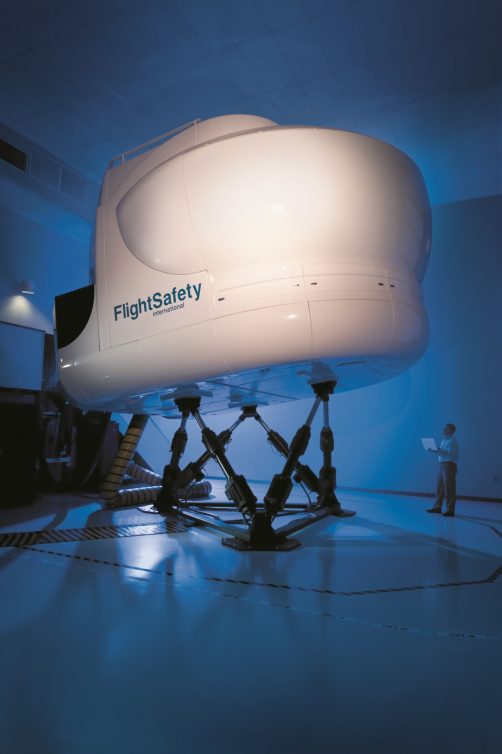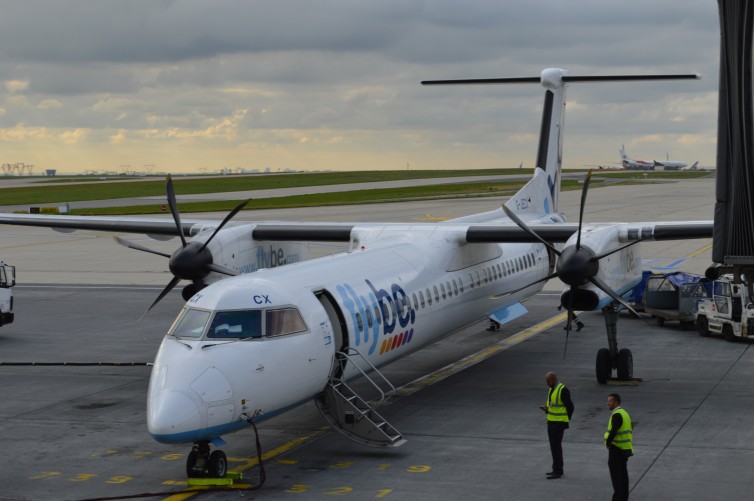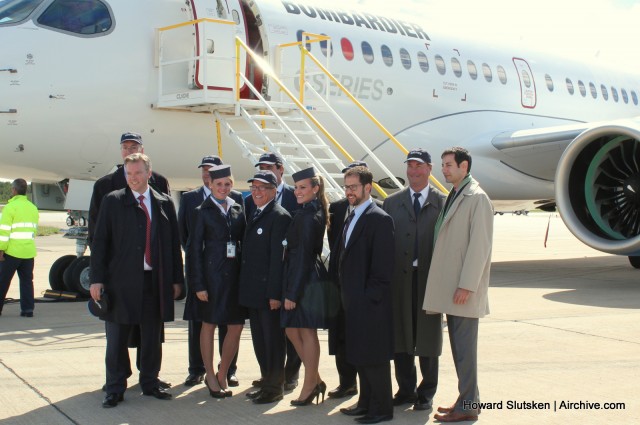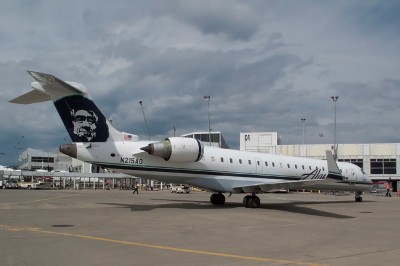
FlightSafety Simulator – Photo: FlightSafety International Inc

Our ride: Q400 Dash 8 – Photo: Alastair Long

FlightSafety Simulator – Photo: FlightSafety International Inc

Our ride: Q400 Dash 8 – Photo: Alastair Long
So, while Port Moresby (Papua New Guinea, or PNG) may not be a holiday treat, it is certainly better than it has ever been since independence. If you want a tropical holiday, you are going to have to leave the ravenous guard dogs and car jackings of Moresby behind.
Being a huge WWII nerd, I figured my best bet was to head out to either Kavieng (on the island of New Ireland) or Kokopo/Rabual on the island of New Britain. Both of these islands were invaded by the Japanese in 1942, shortly after the attack on Pearl Harbor. The Japanese, however, did not hold on to them long, I will cover that in a later article, because first I have to tell you about the fun one can have at the domestic terminal of Jacksons International Airport.
The airport is chaotic, and there is no air conditioning. To keep machetes and buai out of the terminal there is pre-screening before the sterile area. Check-in opens at least three hours prior to departure to deal with the seemingly-unending lines of people going back from Moresby to their home villages, and the infinite tonnage of excess baggage.
But it all ends up being worth the hassle.

Mr. Robert Deluce, Porter Airlines President & CEO (center) with his team
after CSeries Flight Test Vehicle 1’s (FTV1) first flight on September 16, 2013.
It’s been over six months since Porter Airlines announced their conditional order to buy up to 30 Bombardier CS100s. In order to finalize the order, Porter needs permission from the City of Toronto to operate the CS100s at Billy Bishop Toronto City Airport (YTZ), and has asked for extensions to be added to both ends of the main runway at the waterfront airport. Currently, jets are not allowed to operate from YTZ, and Porter flies Bombardier Q400 turboprops from their YTZ base.
BONUS: Review- Flying Porter Airlines From Toronto to Montreal and Back
On Thursday morning, Toronto’s Deputy City Manager filed a report that analyzed Porter’s requests. Simply, it says that granting approval is premature. Among issues cited, there isn’t yet enough noise or operational performance data on the CS100; runway extension impact and noise modelling has not been completed; and there isn’t a clear direction or plan for YTZ’s expansion, and how it will be funded is in question.
In addition, the agreement banning jets at YTZ expires in 2033, and the report says that the impact of Porter’s request should be considered before this no-jet-noise agreement is extended. Overall, the report recommends that research continue, and that a new report be filed in March 2015. Thursday’s report will be considered by the City’s Executive Committee on December 5th, and depending on the outcome, by the full Council on December 16th.
WestJet has announced their plan to start a regional airline using Bombardier Q400s. This is by no means breaking news, but a story that somehow I missed and have been playing catch up and wanted to share some of the things that I have learned.
For those of you who might not be aware of WestJet, they are a low cost carrier, based at Calgary International Airport (YYC) in Alberta, Canada. Previously, they only operated a fleet of Boeing 737 aircraft in an all-economy layout.
In January of this year, WestJet stated that they were looking into starting up a smaller subset of their almost 100 fleet of 737s. At the time, WestJet President and CEO, Gregg Saretsky, stated, “A short-haul aircraft combined with WestJet’s brand, balance sheet strength and low-cost structure will allow WestJet to profitably accomplish four main goals: Introduce WestJet’s friendly and caring service to many smaller communities who have asked for our service; optimize the size of aircraft to efficiently increase frequency; create new connections between existing WestJet markets; and build additional feed to our current 71-city network so that we can continue to profitably grow and add shareholder value.”
The airline’s management talked with employees and in February, the airline announced that 91% of employees voted in favor to launch the regional airline. I would imagine that WestJet employees do not have a union is one reason the high number.
Then, the fun part came; which aircraft to buy? Although the photos of the Bombardier Q400 in WestJet livery on this story gives away the answer, they were also considering the ATR 72-600.
“We are very impressed with the Q400,” Saretsky stated in a press release. “Both ATR and Bombardier put forward excellent proposals and ultimately we believe the Bombardier Q400’s combination of range, speed and seat density is the best choice to meet the needs of the market and how we plan to operate the regional airline.”
WestJet signed a letter of intent to purchase 20 Q400s with the option to purchase an additional 25 aircraft. The airline hopes to start regional service in 2013.
I was curious how the new Q400s would operate in the WestJet fleet and would there be a different customer service product on the Q400?
“The two airlines will operate under separate certificates. However, they will both be WestJet in every respect — culture, guest experience and even livery,” Robert Palmer, spokesperson for WestJet explained to AirlineReporter.com.
The Q400s will be used on flights lasting about one to two hours and the 737s will fly on longer routes. Both airlines will cover domestic and trans-boarder flying and the Q400s will act as a feeder system for the mainline 737s. Palmer also stated that the Q400s might be placed on current routes that have less demand and free up a 737 for additional service.
On top of starting regional service, WestJet has also stated that they will start offering premium economy seating. Each aircraft will have four rows of seats with 36″ of seat pitch and the addition of priority boarding and complimentary on-board amenities.
With Southwest Airlines flying to larger airports and bringing on the 737-800, Allegiant going from one aircraft type to three and WestJet adding regional service and premium seating, it is anyone’s guess what these low cost carriers will do next.

Alaska Airlines Bombardier CRJ-700 (N215AG) operated by Skywest seen at SEA.Photo by Keith Draycott.
Not too long ago, Seattle-based Horizon Air flew CRJ-700s for the Alaska Air Group. Then, Horizon announced they would get rid of the CRJ-700s and only fly a fleet of Bombardier Q400s). Shortly thereafter, Alaska announced they would absorbthe Horizon brand. Now, Alaska Airlines has contracted out with Skywest to fly Bombardier CRJ-700 regional jets on some of their west coast routes.
The Alaska Air Group felt there was still a need for a 70-person regional jet to serve some of their west coast destinations, resulting in Alaska Airlines contracting with Skywest to fly 22 daily CRJ-700 flights between Seattle/Portland and Burbank, Fresno, Long Beach, Ontario and Santa Barbara.
Interesting enough, Skywest is leasing the CRJ-700s from Horizon Air and flying them for Alaska under the new brand. The regional jets will sport the Alaska Airlines livery with a smaller “Skywest” on the fuselage. The interior will have blue leather seating, to match what you might find on an Alaska Air Boeing 737. However, the service will mirror what you would expect from flying on Horizon Air (yay free beer and wine).
“Alaska’s goal is to create a consistent customer experience on all of its regional-aircraft flights and provide a level of service including beer and wine that will compete against other regional airlines that offer a first class cabin,” Marianne Lindsey, Alaska Airlines Corporate Communications explained to Airline Reporter. “Coffee, napkins, cups, the inflight magazine, flight attendant uniforms and flight attendant announcements will match Alaska’s. Boarding passes and a decal next to the aircraft boarding door will indicate the flights are being operated for Alaska by SkyWest.”
Horizon hopes to have a single fleet of Q400’s by June 1st, matching Alaska’s single fleet of Boeing 737s. It becomes more economical for Horizon to lease the aircraft through Skywest since they have many more CRJs in their fleet, allowing economies of scale that Horizon or Alaska cannot match.
Horizon Air employees are trained to work with the CRJ-700, but since they will now be operated by Skywest, there will be some operational changes that have required employees to go through some re-training. “More than 2,200 employees at Alaska, Horizon, SkyWest and our partner vendors have been trained,” Lindsey explained. “More than 40 computer systems have been integrated and more than 400 processes have been confirmed–all to ensure safety and compliance, as well as a seamless product for our customers.”
Alaska didn’t indicate that it immediate plans for additional routes to be flown by the CRJ-700s. “We’re continually evaluating demand in all Alaska markets and will ensure the aircraft type and frequency (or capacity) continue to match demand throughout the Alaska system,’ Lindsey confirmed.
I would imagine there could be some hiccups with so many changes happening at one time for the new Alaska, old Horizon and the addition of Skywest. However, Alaska has a good track record of keeping people informed and trying to make the changes unnoticeable to their customer. Although many of us airline geeks will notice a change of aircraft type and livery, most people just want to get from point A to B as safe and cheaply as possible.
Being a Seattle native, I have mixed feelings seeing the Horizon brand slowly going away. Alaska needs to be able to compete and keep themselves a strong independent airline. They have weathered many economic downturns without having to sell or merge. It is a love/hate relationship and it helps that Alaska Air’s livery looks so darn good on the Bombardier Q400 and CRJ-700.
Things of interest:
* Schedule of the Skywest CRJ-700s
* Photo of CRJ-700 in Horizon livery (N601QX which is now N215AG)
* An ex-Horizon CRJ-700 caught in Atlanta (N604QX)
* Photo of Alaska livery on CRJ-700 in flight (N215AG)
* Another photos of CRJ in AS livery on the ground (N215AG)
Image by Keith Draycott via Flickr